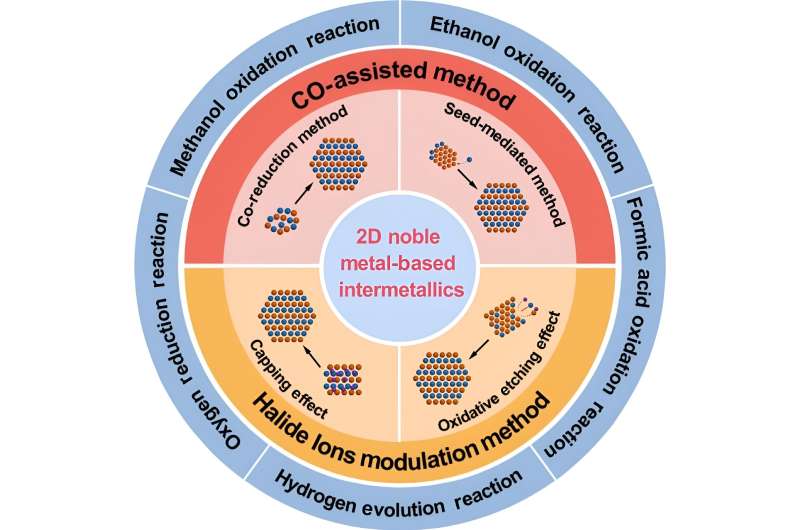This article has been reviewed according to Science X's editorial process and policies. Editors have highlighted the following attributes while ensuring the content's credibility:
fact-checked
proofread
Reviewing the state of research into 2D noble metal-based intermetallic compound electrocatalysts

As demand grows for more sustainable and efficient energy generation, electrochemical energy conversion technologies that rely on electrocatalysis stand out as promising alternatives. Research into the best type of electrocatalysts is ongoing.
Two-dimensional noble metal-based alloy electrocatalysts are cost-effective and accessible but have significant disadvantages, including weak interaction between the atoms in the alloy leading to instability and reduced activity.
However, adding intermetallic compounds (IMCs) to the alloy improves the interaction between the different elements and has added benefits. Research published in Energy Materials and Devices reviews current research into developing 2D noble metal-based IMCs and their benefits.
"Until now, a comprehensive review of the synthesis of 2D noble metal-based IMCs and their potential applications in electrocatalysis is lacking. This review fills that gap by providing a comprehensive overview of the synthesis methods for 2D noble metal-based IMCs, including the CO-assisted and halide ion modulation methods. The review also addresses current challenges in the synthesis and electrocatalytic application of 2D noble metal-based IMCs," said Fukai Feng, a professor at the University of Science and Technology Beijing in Beijing, China.
In the paper, researchers first look at the different processes for synthesizing 2D noble metal-based IMCs, which include the CO-assisted and halide ion modulation methods. They then summarize their applications in electrocatalysis.
There are certain beneficial properties of electrocatalysts that can be achieved during the synthesis process, including symmetry reduction. This is desirable because reducing the symmetry of a catalyst improves electrocatalytic activity.
The synthesis methods analyzed in this paper include the CO-assisted method and a halide ion modulation method. Both methods have their advantages, depending on the type of 2D noble metal-based IMC desired.
After analyzing synthesis methods, researchers looked at the different real-world applications of 2D noble metal-based IMCs in electrocatalysis.
"The unique properties of 2D noble metal-based IMCs, including anisotropy (non-uniformity), numerous active sites, unsaturated coordination of atoms on the surface, and electron transfer efficiency, contribute to their excellent catalytic properties," said Feng.
An example of a real-world application of a 2D noble metal-based IMC is in a direct ethanol fuel cell. This clean energy source is interesting because it is renewable, easy to store and transport, and it has a high energy density. Catalysts used in direct ethanol fuel cells tend to absorb more of toxic intermediary byproducts. However, the 2D noble metal-based IMCs inhibit this absorption.
Researchers noted that there were areas where fewer studies have been done, such as on the use of 2D noble metal-based IMCs for the electrochemical process that occurs at the cathode during electrochemical water splitting for hydrogen evolution.
Looking ahead, researchers hope that several challenges of 2D noble metal-based IMC electrocatalysts are addressed, including synthesizing the 2D noble metal-based IMCs and the metals used for this process. This is a challenging process because of their inherent anisotropy and high surface energy.
Another challenge faced during the synthesis process is the surfactant byproducts that remain after synthesis, which reduce the effectiveness of the catalysts. Though a method called thermal annealing can remove the need for surfactants, this process comes with its own challenges.
Researchers would like to see new methods of synthesizing the 2D noble metal-based IMCs with thermal annealing. Finally, researchers would like to see 3D structures built from the 2D noble metal-based IMCs to improve long-term stability of the catalysts and more broad applications of this technology explored.
Other contributors include Sumei Han and Qipeng Lu of the School of Materials Science and Engineering at the University of Science and Technology Beijing and Qinbai Yun at the Department of Chemical and Biological Engineering & Energy Institute at the Hong Kong University of Science and Technology.
More information: Fukai Feng et al, Two-dimensional noble metal-based intermetallics for electrocatalysis, Energy Materials and Devices (2023). DOI: 10.26599/EMD.2023.9370008
Provided by Tsinghua University Press





















